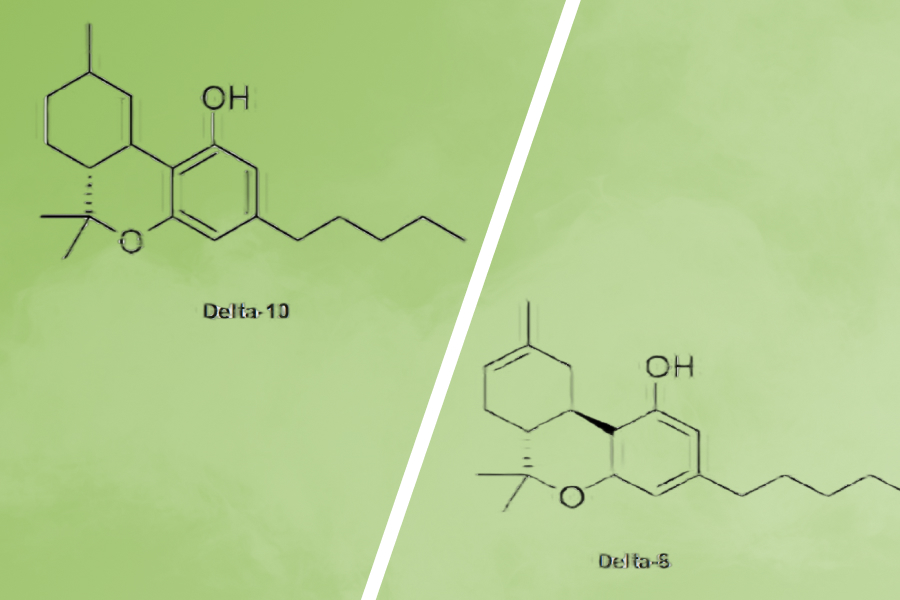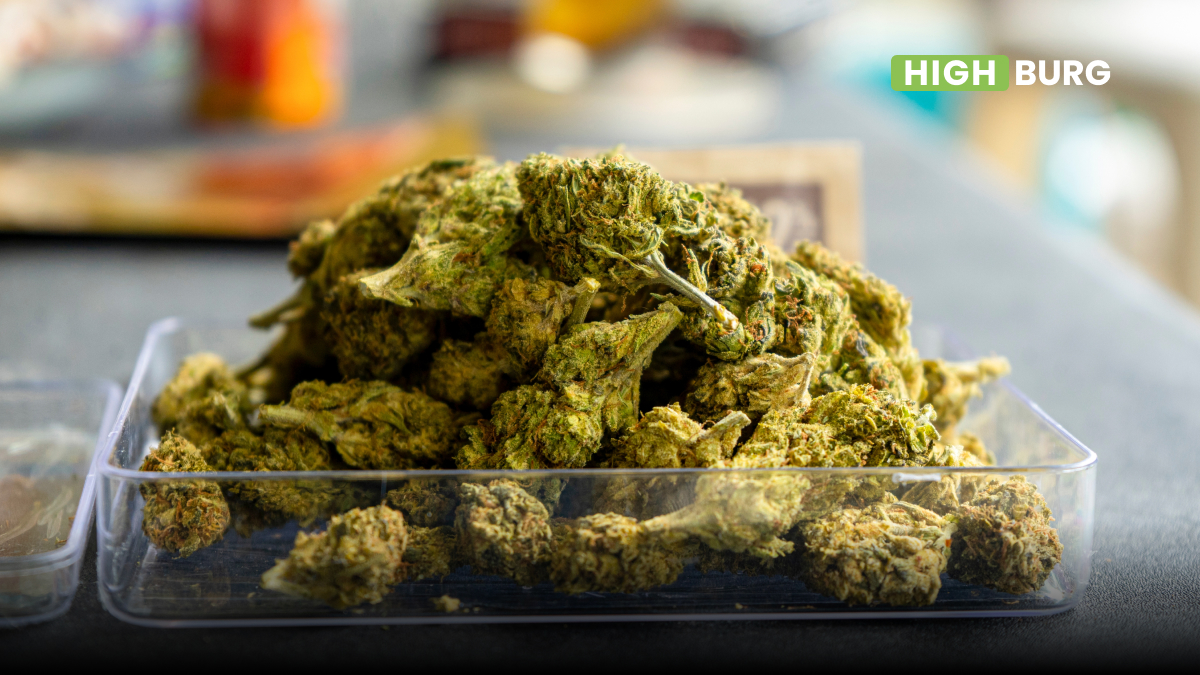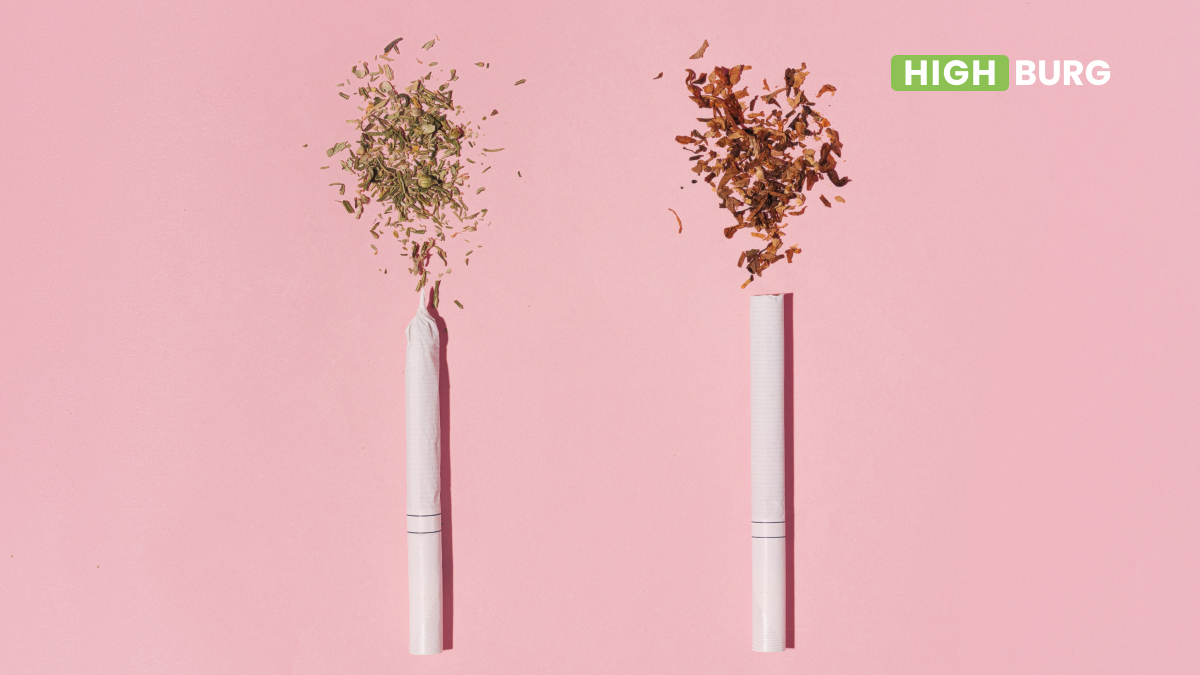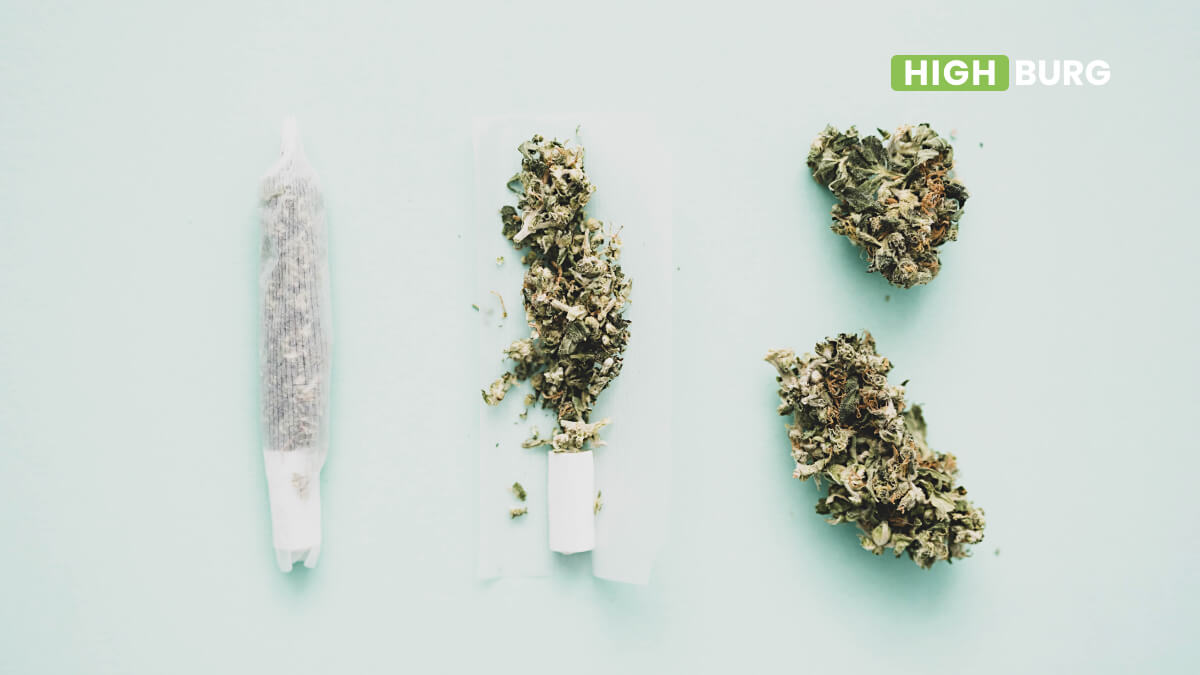There are a variety of differences between Delta 10 vs Delta 8, and if you’re into consuming cannabis on a regular basis, it’s helpful to know what they are.
Delta 10 and Delta 8 are the two main types of cannabinoids found in cannabis, and each type has its own unique effects on the body and mind. Here’s everything you need to know about Delta 10 vs Delta 8 so you can choose which one works best for your needs.
What Is Delta 10 THC?
Delta 10 THC is a potent cannabinoid found in cannabis plants. It’s similar to the more well-known Delta-9 THC, but it has a few key differences that make it unique. Some users report that Delta 10 provides a more clear-headed high than its counterpart, while some say that it provides more uplifting effects.
There are also fewer reports of dizziness and paranoia when using this type of weed. On the other hand, some studies have shown that Delta 10 can have negative effects on certain aspects of memory formation when consumed too often.
Furthermore, that has been some research that indicates that it might be an effective treatment for people with diabetes because it can potentially help to stabilize blood sugar levels.
What Is Delta 8 THC?
Delta 8 THC is another cannabinoid that occurs naturally in the cannabis plant. Delta 8 THC is only found in trace amounts in most strains of cannabis. However, thanks to modern extraction methods, it’s now possible to isolate and concentrate this cannabinoid. When consumed, Delta 8 THC produces a high that is mildly similar to, but less intense than the high caused by Delta 9 THC.
Delta-8 THC is less psychoactive than regular THC. This means that it won’t get you as high. Additionally, Delta-8 THC has a lower binding affinity for the CB1 receptor than regular THC. This means that it produces different effects in the body than regular THC. For example, Delta-8 THC stimulates appetite more than regular THC does.
It also activates TRPV1 receptors more intensely than other cannabinoids do. TRPV1 receptors are responsible for telling the brain when we’re hungry or when we need water or salt. The upshot of this is that Delta-8 THC may help increase calorie intake and regulate your appetite levels.
Delta 10 Vs Delta 8
The cannabis industry is evolving every day. New strains, products, and ways to consume are constantly being created. This can be overwhelming for consumers, especially those new to the scene. When you compare Delta 10 vs Delta 8, there are a few notable differences to look at.
First off, there isn’t a huge difference in potency between the two, but reports state that Delta 8 has a mild upper hand. However, Delta 10 has more CBD than Delta 8, which has a little more THC.
So if you’re looking for relief without getting high then you should opt for Delta 10; while if you want a buzz with minimal pain relief then go with Delta 8. The ratio is typically 1:1 when it comes to these cannabinoids, but keep in mind that it may vary depending on who’s making them!
Overall, it’s really personal preference as both are known for their medicinal benefits. It just depends on what your needs are and what you prefer- and again, this varies from person to person.
Effects Of THC Consumption (Greater Psychoactive Effect Than CBD)
Cannabis is a psychoactive drug from the cannabis plant, which is often used for medical or recreational purposes. The main psychoactive component of cannabis is tetrahydrocannabinol (THC), one of 483 known compounds in the plant, including at least 65 other cannabinoids.
THC is the principal psychoactive constituent of cannabis. When consumed, typically via smoking or ingestion, THC produces a euphoric effect. This is caused by THC binding to cannabinoid receptors in the brain, where it activates the neurotransmitter release of dopamine.
CBD does not bind with these receptors. Studies suggest that CBD may help reduce anxiety and depression without causing any noticeable drowsiness. It may also help reduce chronic pain, inflammation, and nausea. It can cause the user to feel relaxed without feeling drowsy or lethargic.
Both Delta 10 and Delta 8 have their benefits depending on what you need. If you are looking for more medicinal effects such as anti-inflammatory properties and mood regulation then Delta 8 would be best suited for you but if you are looking for more psychotropic effects then Delta 10 would be best suited for you!
Risks Associated With Overconsumption Of THC
When it comes to consuming cannabis, more is not always better. In fact, overconsumption of THC can lead to a number of unpleasant side effects including anxiety, paranoia, and dizziness.
For some people, these effects can be so severe that they significantly interfere with their ability to function normally. Additionally, overconsumption of THC can exacerbate underlying mental health conditions such as depression and schizophrenia. Therefore, it is important to start with small doses and increase gradually as needed.
There are three major ways in which the intensity of the effects of THC can be altered: 1) by changing your route of administration; 2) by lowering your tolerance; 3) by eating. Other factors, such as smoking habits, genetic differences in how our bodies process cannabinoids, the mood at the time of consumption, and even other medications you may take will also have an impact on the effects you experience.
As we grow increasingly aware of the risks associated with overconsumption of THC, there has been a corresponding decrease in the availability of high-THC products (e.g., strains). Those who seek out higher levels of THC should do so cautiously, understanding both its benefits and drawbacks.
What Is The Different Between THC And CBD?
CBD and THC are the two main cannabinoids found in the cannabis plant. CBD is non-psychoactive, meaning it won’t get you high. THC is psychoactive, meaning it will get you high.
Cannabis plants contain both THC and CBD, with each compound occurring in varying ratios. Some strains contain more CBD than THC and vice versa. A high-CBD strain typically has a low amount of THC while a low-THC strain has a high amount of it.
In general, strains with higher percentages of CBD tend to produce fewer psychoactive effects when smoked or consumed orally compared to those with lower amounts of this cannabinoid compound.
THC has a higher amount of tetrahydrocannabinol (THC) in it than cannabidiol (CBD). This means that THC has more psychoactive properties than CBD does. In other words, THC makes people feel high while CBD does not.
After this first difference, CBD has another advantage over THC in that it is much more effective at treating medical conditions than THC is. For example, there are several studies showing that CBD can help with anxiety and depression while THC is not as effective at treating these issues.
One final difference between THC and CBD is that it seems that CBD has fewer side effects than THC does when taken in large quantities over an extended period of time.
What Are The Uses Of CBD?
CBD has many uses. It can be used to treat a variety of conditions, including anxiety, pain, and inflammation. CBD is also known to help with sleep, nausea, and even PTSD.
Here are some of the most common ways you can use CBD:
Anxiety – There is a lot of research showing that CBD can be useful for treating anxiety disorders like PTSD and social anxiety.
Pain – Some studies have shown that CBD may help with pain control in people with chronic pain conditions such as arthritis or multiple sclerosis (MS).
Inflammation – Research suggests that CBD can help reduce inflammation by reducing the activity of cells called T cells in the immune system. In addition, it has been shown to reduce inflammation associated with arthritis, multiple sclerosis (MS), and other inflammatory conditions.
PTSD – People who suffer from post-traumatic stress disorder (PTSD) often experience intense anxiety along with flashbacks to their traumatic event when they’re exposed to reminders of it — like seeing a picture of someone who was involved in the trauma or hearing someone mention it. There are many different treatments for PTSD, but one that has shown promise in using cannabidiol (CBD) supplements because they contain natural compounds.
What Are The Uses Of THC?
The most common uses of THC are for:
Pain relief – THC is the most common cannabinoid found in cannabis. It’s known to reduce pain and inflammation. This makes it an excellent way to treat various types of pain, including migraines, arthritis, and cancer pain.
Nausea – Some research shows that THC can be used as a treatment for nausea caused by chemotherapy. Other studies point to its benefits as a supplement for people suffering from chronic nausea from other conditions, such as multiple sclerosis, and the side effects of some medications.
Inflammation – Some research has suggested that THC could even have anti-inflammatory effects on the brain, which could help with conditions like multiple sclerosis or rheumatoid arthritis (an autoimmune condition). Another study suggests that it may help with inflammation caused by injury or infection.
Mood elevation – While there isn’t much science behind this claim, many people report feeling happier after using marijuana recreationally. The relaxation effect of THC can also help improve mood in those who suffer from depression or anxiety disorders.
Cognitive function – Studies have shown that marijuana can improve short-term memory in both animals and humans.
Which Strains Have High Levels Of THC?
There are several strains that have high levels of THC. The most popular strains are:
1. Jack Herer
Jack Herer is a sativa-dominant hybrid that’s been around since the 70s or 80s. The strain has an earthy aroma and taste, with notes of pine and citrus. Jack Herer cannabis seeds can be grown indoors or out, though these seeds are best for growing outdoors in cooler climates where plants will need some extra heat to thrive.
2. White Widow
White Widow is a sativa-dominant hybrid. It’s a tall plant that grows upwards of three feet tall, making it a great choice for growing indoors or outdoors in the right conditions.
White Widow has a sweet aroma, with notes of citrus and woodsy undertones. The flavor is smooth, with notes of pine, earthiness, and citric flavors like lemon and lime.
The effects of White Widow are energizing and intense, but not too strong to make you feel paranoid or uncomfortable. It also tends to leave you feeling happy instead of euphoric — more like an uplifted mood than anything else.
White Widow is known as one of the best cannabis strains for pain relief due to its high CBD content (upwards of 12%) and low THC levels (around 8%). This makes it ideal for people who want to medicate without feeling too “high” or out of control.
3. Northern Lights
Northern Lights is a cross between Thai and Afghani. This strain has gained popularity in recent years due to its effects on the body. Northern Lights is a very potent strain, producing intense cerebral effects that are often described as spiritual.
Northern Lights is a cross between Thai and Afghani. This strain has gained popularity in recent years due to its effects on the body. Northern Lights is a very potent strain, producing intense cerebral effects that are often described as spiritual.
The high of Northern Light cannabis strains can last up to two hours or more depending on how much you smoke. The high begins with a heady rush of energy and euphoria that lasts just as long as it takes for the high to wear off. Those who smoke this strain regularly report feeling extremely creative and motivated throughout the day, but by evening they will likely feel tired and sleepy, which makes it easier to fall asleep at night.
4. Haze (also known as Skunk #1)
Skunk #1 is a solid, old-school sativa that produces plenty of resin. It’s a quick-growing plant with thick, bushy buds that have a strong citrus aroma and flavor. The high is cerebral and euphoric, with a strong physical body buzz and a clear headspace.
Skunk #1 was one of the first strains to be bred in California back in the early 70s. It has been used for decades by medical users seeking relief from pain, depression, and anxiety, but now it’s also gaining popularity as a recreational cannabis strain because of its potency and high THC content (20%).
Which Strains Have High Levels Of Cbd?
In the same way that there are many strains of cannabis that have high levels of CBD, there are also strains that contain high levels of THC:
1. Ringo’s Gift
Ringo’s Gift is best used as a medicine for treating pain, anxiety, depression, and even muscle spasms. It can also be used to help people with insomnia and sleep problems as well as appetite loss when going through chemotherapy treatments.
2. Harlequin
The Harlequin strain of weed is a very popular CBD strain that can help you clear your head and increase your levels of focus.
3. Sweet And Sour Widow
Sweet and Sour Widow is another strain of cannabis that is high in CBD. This strain is perfect for new cannabis users who are looking to try out different strains.
4. ACDC
ACDC is a strain that has a 20:1 CBD to THC ratio, making it perfect for users who are dealing with pain and anxiety.
Can THC Relieve Inflammation?
Some studies suggest that THC—the main psychoactive compound in cannabis—may help to reduce inflammation. A 2006 study found that THC was able to decrease inflammation in rats by inhibiting the production of pro-inflammatory cytokines.
Another study from 2010 found that THC may help to decrease inflammation by modulating the body’s endocannabinoid system. The researchers discovered that mice with a condition similar to rheumatoid arthritis experienced decreased levels of inflammation when they were given a daily dose of THC for 12 weeks.
These results, coupled with evidence that suggests a link between autoimmune disorders and chronic inflammation, have led some experts to believe that cannabinoid therapy is an effective treatment for various types of inflammatory conditions.
However, more research needs to be done before doctors can determine whether or not it would be safe and beneficial for people living with autoimmune diseases like Crohn’s disease or lupus to take cannabinoids as part of their treatments.
Final Thoughts
While there are a few differences between Delta 10 vs Delta 8, many new cannabis users might not be able to tell the difference. With so many different types of cannabis on the market, it always helps to try out various strains of cannabis to see what works best for you.



